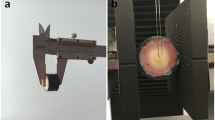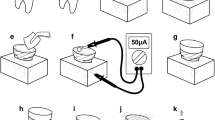Abstract
The objective of this study was to evaluate the influence of CO2 9.3 μm short-pulsed laser irradiation on the shear bond strength of composite resin to enamel and dentin. Two hundred enamel and 210 dentin samples were irradiated with a 9.3 µm carbon dioxide laser (Solea, Convergent Dental, Inc., Natick, MA) with energies which either enhanced caries resistance or were effective for ablation. OptiBond Solo Plus [OptiBondTE] (Kerr Corporation, Orange, CA) and Peak Universal Bond light-cured adhesive [PeakTE] (Ultradent Products, South Jordan, UT) were used. In addition, Scotchbond Universal [ScotchbondSE] (3M ESPE, St. Paul, MN) and Peak SE self-etching primer with Peak Universal Bond light-cured adhesive [PeakSE] (Ultradent Products) were tested. Clearfil APX (Kuraray, New York, NY) was bonded to the samples. After 24 h, a single plane shear bond test was performed. Using the caries preventive setting on enamel resulted in increased shear bond strength for all bonding agents except for self-etch PeakSE. The highest overall bond strength was seen with PeakTE (41.29 ± 6.04 MPa). Etch-and-rinse systems achieved higher bond strength values to ablated enamel than the self-etch systems did. PeakTE showed the highest shear bond strength with 35.22 ± 4.40 MPa. OptiBondTE reached 93.8% of its control value. The self-etch system PeakSE presented significantly lower bond strength. The shear bond strength to dentin ranged between 19.15 ± 3.49 MPa for OptiBondTE and 43.94 ± 6.47 MPa for PeakSE. Etch-and-rinse systems had consistently higher bond strength to CO2 9.3 µm laser-ablated enamel. Using the maximum recommended energy for dentin ablation, the self-etch system PeakSE reached the highest bond strength (43.9 ± 6.5 MPa).






Similar content being viewed by others
References
Van Meerbeek B, Yoshihara K, Yoshida Y, Mine A, De Munck J, Van Landuyt KL (2011) State of the art of self-etch adhesives. Dent Mater 27(1):17–28. doi:10.1016/j.dental.2010.10.023
Pashley DH, Tay FR, Breschi L, Tjaderhane L, Carvalho RM, Carrilho M, Tezvergil-Mutluay A (2011) State of the art etch-and-rinse adhesives. Dent Mater 27(1):1–16. doi:10.1016/j.dental.2010.10.016
Perdigao J, Frankenberger R, Rosa BT, Breschi L (2000) New trends in dentin/enamel adhesion. Am J Dent 13(Spec No):25D–30D
Voss JE, Charbeneau GT (1979) A scanning electron microscope comparison of three methods of bonding resin to enamel rod ends and longitudinally cut enamel. J Am Dent Assoc 98(3):384–389
Reis A, Zander-Grande C, Kossatz S, Stanislawczuk R, Manso A, de Carvalho RM, Loguercio AD (2010) Effect of mode of application on the microtensile bond strength of a self-etch and etch-and-rinse adhesive system. Oper Dent 35(4):428–435. doi:10.2341/09-319-L
Staninec M, Gardner AK, Le CQ, Sarma AV, Fried D (2006) Adhesion of composite to enamel and dentin surfaces irradiated by IR laser pulses of 0.5–35 micros duration. J Biomed Mater Res B Appl Biomater 79(1):193–201. doi:10.1002/jbm.b.30530
Hossain M, Yamada Y, Nakamura Y, Murakami Y, Tamaki Y, Matsumoto K (2003) A study on surface roughness and microleakage test in cavities prepared by Er:YAG laser irradiation and etched bur cavities. Lasers Med Sci 18(1):25–31. doi:10.1007/s10103-002-0235-5
Staninec M, Xie J, Le CQ, Fried D (2003) Influence of an optically thick water layer on the bond-strength of composite resin to dental enamel after IR laser ablation. Lasers Surg Med 33(4):264–269. doi:10.1002/lsm.10229
Ozer T, Basaran G, Berk N (2008) Laser etching of enamel for orthodontic bonding. Am J Orthod Dentofac Orthop 134(2):193–197. doi:10.1016/j.ajodo.2006.04.055
Wigdor H, Abt E, Ashrafi S, Walsh JTJ (1993) The effect of lasers on dental hard tissues. J Am Dent Assoc 124:65–70
Takamori K (2000) A histopathological and immunohistochemical study of dental pulp and pulpal nerve fibers in rats after the cavity preparation using Er:YAG laser. J Endod 26(2):95–99. doi:10.1097/00004770-200002000-00009
Freitas PM, Navarro RS, Barros JA, de Paula Eduardo C (2007) The use of Er:YAG laser for cavity preparation: an SEM evaluation. Microsc Res Tech 70(9):803–808. doi:10.1002/jemt.20470
Delme KI, De Moor RJ (2007) Scanning electron microscopic evaluation of enamel and dentin surfaces after Er:YAG laser preparation and laser conditioning. Photomed Laser Surg 25(5):393–401. doi:10.1089/pho.2006.2069
De Munck J, Van Meerbeek B, Yudhira R, Lambrechts P, Vanherle G (2002) Micro-tensile bond strength of two adhesives to erbium:YAG-lased vs. bur-cut enamel and dentin. Eur J Oral Sci 110(4):322–329
Martinez-Insua A, Da Silva Dominguez L, Rivera FG, Santana-Penin UA (2000) Differences in bonding to acid-etched or Er:YAG-laser-treated enamel and dentin surfaces. J Prosthet Dent 84(3):280–288. doi:10.1067/mpr.2000.108600
Chimello-Sousa DT, de Souza AE, Chinelatti MA, Pecora JD, Palma-Dibb RG, Milori Corona SA (2006) Influence of Er:YAG laser irradiation distance on the bond strength of a restorative system to enamel. J Dent 34(3):245–251. doi:10.1016/j.jdent.2005.06.009
Fried D, Zuerlein MJ, Le CQ, Featherstone JD (2002) Thermal and chemical modification of dentin by 9–11-microm CO2 laser pulses of 5–100-micros duration. Lasers Surg Med 31(4):275–282
Zuerlein MJ, Fried D, Featherstone JDB, Seka W (1999) Optical properties of dental enamel in the mid-IR determined by pulsed photothermal radiometry. IEEE J Sel Top Quantum 5(4):1083–1089. doi:10.1109/2944.796333
Featherstone JD, Barrett-Vespone NA, Fried D, Kantorowitz Z, Seka W (1998) CO2 laser inhibitor of artificial caries-like lesion progression in dental enamel. J Dent Res 77(6):1397–1403
Kantorowitz Z, Featherstone JD, Fried D (1998) Caries prevention by CO2 laser treatment: dependency on the number of pulses used. J Am Dent Assoc 129(5):585–591
Rechmann P, Rechmann BM, Groves WH Jr, Le CQ, Rapozo-Hilo ML, Kinsel R, Featherstone JD (2016) Caries inhibition with a CO2 9.3 μm laser: an in vitro study. Lasers Surg Med 48(5):546–554. doi:10.1002/lsm.22497
Rechmann P, Charland DA, Rechmann BM, Le CQ, Featherstone JD (2013) In-vivo occlusal caries prevention by pulsed CO2-laser and fluoride varnish treatment—a clinical pilot study. Lasers Surg Med 45(5):302–310. doi:10.1002/lsm.22141
Rechmann P, Fried D, Le CQ, Nelson G, Rapozo-Hilo M, Rechmann BM, Featherstone JD (2011) Caries inhibition in vital teeth using 9.6-μm CO2-laser irradiation. J Biomed Opt 16(7):071405. doi:10.1117/1.3564908
Rechmann P, Sherathiya K, Kinsel R, Vaderhobli R, Rechmann BM (2017) Influence of irradiation by a novel CO2 9.3 μm short-pulsed laser on sealant bond strength. Lasers Med Sci 32(3):609–620. doi:10.1007/s10103-017-2155-4
Featherstone JD, Nelson DG (1987) Laser effects on dental hard tissues. Adv Dent Res 1(1):21–26
Mortazavi V, Fathi M, Ataei E, Khodaeian N, Askari N (2012) Shear bond strengths and morphological evaluation of filled and unfilled adhesive interfaces to enamel and dentine. Int J Dent 2012:858459. doi:10.1155/2012/858459
Kimmes NS, Barkmeier WW, Erickson RL, Latta MA (2010) Adhesive bond strengths to enamel and dentin using recommended and extended treatment times. Oper Dent 35(1):112–119. doi:10.2341/09-081-L
Pivetta MR, Moura SK, Barroso LP, Lascala AC, Reis A, Loguercio AD, Grande RH (2008) Bond strength and etching pattern of adhesive systems to enamel: effects of conditioning time and enamel preparation. J Esthet Restor Dent 20(5):322–335; discussion 336. doi:10.1111/j.1708-8240.2008.00202.x
Khoroushi M, Aghelinejad S (2011) Effect of postbleaching application of an antioxidant on enamel bond strength of three different adhesives. Med Oral Patol Oral Cir Bucal 16(7):e990–e996
Ertugrul F, Turkun M, Turkun LS, Toman M, Cal E (2009) Bond strength of different dentin bonding systems to fluorotic enamel. J Adhes Dent 11(4):299–303
Price R, McLeod M, Felix CM (2008) Bond strengths of self-etching bonding systems to dentin and enamel. J Dent Res 87(Spec Iss A:0825)
Michaud PL, MacKenzie A (2016) Compatibility between dental adhesive systems and dual-polymerizing composite resins. J Prosthet Dent. doi:10.1016/j.prosdent.2016.04.001
Isolan CP, Valente LL, Münchow EA, Basso GR, Pimentel AH, Schwantz JK, da Silva AV, Moraes RR (2014) Bond strength of a universal bonding agent and other contemporary dental adhesives applied on enamel, dentin, composite, and porcelain. Appl Adhes Sci 2(1):1–10. doi:10.1186/s40563-014-0025-x
Thalacker C, Loll H, Wiedig CA, Krueger DD (2012) Total-etch performance of one bottle self-etch adhesives. J Dent Res 91(A):790
Suzuki T, Takamizawa T, Barkmeier WW, Tsujimoto A, Endo H, Erickson RL, Latta MA, Miyazaki M (2016) Influence of etching mode on enamel bond durability of universal adhesive systems. Oper Dent. doi:10.2341/15-347-L
Nguyen D, Chang K, Hedayatollahnajafi S, Staninec M, Chan K, Lee R, Fried D (2011) High-speed scanning ablation of dental hard tissues with a λ = 9.3 μm CO2 laser: adhesion, mechanical strength, heat accumulation, and peripheral thermal damage. J Biomed Opt 16(7):071410. doi:10.1117/1.3603996
Soderholm KJ, Soares F, Argumosa M, Loveland C, Bimstein E, Guelmann M (2008) Shear bond strength of one etch-and-rinse and five self-etching dental adhesives when used by six operators. Acta Odontol Scand 66(4):243–249. doi:10.1080/00016350802220088
Heintze SD, Rousson V (2012) Clinical effectiveness of direct class II restorations—a meta-analysis. J Adhes Dent 14(5):407–431. doi:10.3290/j.jad.a28390
Sarrett DC (2007) Prediction of clinical outcomes of a restoration based on in vivo marginal quality evaluation. J Adhes Dent 9(Suppl 1):117–120
Andre CB, Gomes BP, Duque TM, Stipp RN, Chan DC, Ambrosano GM, Giannini M (2015) Dentine bond strength and antimicrobial activity evaluation of adhesive systems. J Dent 43(4):466–475. doi:10.1016/j.jdent.2015.01.004
Pecora N, Yaman P, Dennison J, Herrero A (2002) Comparison of shear bond strength relative to two testing devices. J Prosthet Dent 88(5):511–515. doi:10.1067/mpr.2002.129063
Teixeira CS, Chain MC (2010) Evaluation of shear bond strength between self-etching adhesive systems and dentin and analysis of the resin-dentin interface. Gen Dent 58(2):e52–e61
Munoz MA, Luque I, Hass V, Reis A, Loguercio AD, Bombarda NH (2013) Immediate bonding properties of universal adhesives to dentine. J Dent 41(5):404–411. doi:10.1016/j.jdent.2013.03.001
Takamizawa T, Barkmeier WW, Tsujimoto A, Berry TP, Watanabe H, Erickson RL, Latta MA, Miyazaki M (2016) Influence of different etching modes on bond strength and fatigue strength to dentin using universal adhesive systems. Dent Mater 32(2):e9–21. doi:10.1016/j.dental.2015.11.005
Ferracane JL, Hilton TJ (2016) Polymerization stress—is it clinically meaningful? Dent Mater 32(1):1–10. doi:10.1016/j.dental.2015.06.020
Price RB, Derand T, Andreou P, Murphy D (2003) The effect of two configuration factors, time, and thermal cycling on resin to dentin bond strengths. Biomaterials 24(6):1013–1021
Price RB, Hall GC (1999) In vitro comparison of 10-minute versus 24-hour shear bond strengths of six dentin bonding systems. Quintessence Int 30(2):122–134
Munksgaard EC, Irie M, Asmussen E (1985) Dentin-polymer bond promoted by Gluma and various resins. J Dent Res 64(12):1409–1411
Acknowledgements
Thanks to Khanh Nguyen and Brian Po Lee, UCSF, School of Dentistry, Class of 2017 for helping with the sample preparation.
Author information
Authors and Affiliations
Corresponding author
Ethics declarations
Conflicts of interest
The authors declare that they have no conflict of interest.
Funding
This study is the principal investigator’s initiated study and was funded by the Convergent Dental, Inc. through the University of California, San Francisco’s Contracts & Grants Division.
Rights and permissions
About this article
Cite this article
Rechmann, P., Bartolome, N., Kinsel, R. et al. Bond strength of etch-and-rinse and self-etch adhesive systems to enamel and dentin irradiated with a novel CO2 9.3 μm short-pulsed laser for dental restorative procedures. Lasers Med Sci 32, 1981–1993 (2017). https://doi.org/10.1007/s10103-017-2302-y
Received:
Accepted:
Published:
Issue Date:
DOI: https://doi.org/10.1007/s10103-017-2302-y




